can句型lessonplan 新
- 格式:doc
- 大小:22.84 KB
- 文档页数:8
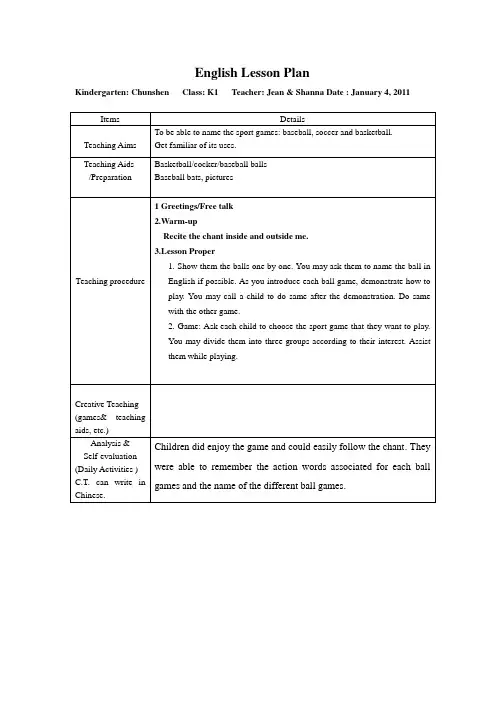
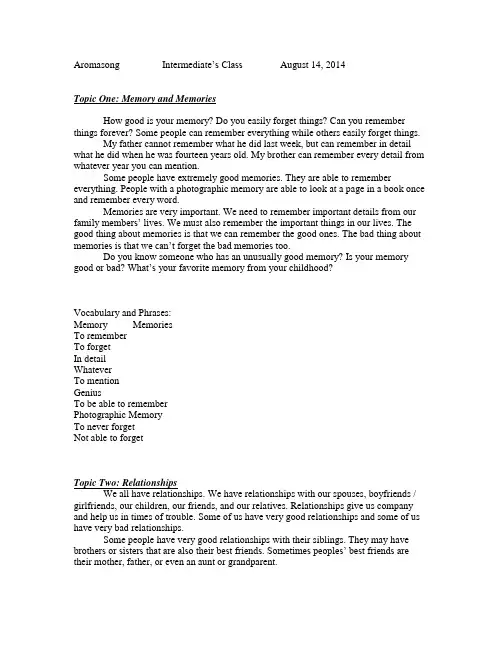
Aromasong Intermediate’s Class August 14, 2014Topic One: Memory and MemoriesHow good is your memory? Do you easily forget things? Can you remember things forever? Some people can remember everything while others easily forget things.My father cannot remember what he did last week, but can remember in detail what he did when he was fourteen years old. My brother can remember every detail from whatever year you can mention.Some people have extremely good memories. They are able to remember everything. People with a photographic memory are able to look at a page in a book once and remember every word.Memories are very important. We need to remember important details from our family members’ lives. We must also remember the important things in our lives. The good thing about memories is that we can remember the good ones. The bad thing about memories is that we can’t forget the bad memories too.Do you know someone who has an unusually good memory? Is your memory good or bad? What’s your favorit e memory from your childhood?Vocabulary and Phrases:Memory MemoriesTo rememberTo forgetIn detailWhateverTo mentionGeniusTo be able to rememberPhotographic MemoryTo never forgetNot able to forgetTopic Two: RelationshipsWe all have relationships. We have relationships with our spouses, boyfriends / girlfriends, our children, our friends, and our relatives. Relationships give us company and help us in times of trouble. Some of us have very good relationships and some of us have very bad relationships.Some people have very good relationships with their siblings. They may have brothers or sisters that are also their best friends. Sometimes peoples’ best friends are their mother, father, or even an aunt or grandparent.It is important to have good relationships in our lives. What is the best relationship that you have?Vocabulary and Phrases:RelationshipsSpouseTo have companyIn times of troubleSiblingsDiscussion:What are the relationships in your life?Who is your best friend? Why?Who do you like the best? Who do you hate?Is there anyone you don’t like but have to see all the time?Are there people you love to be around?。
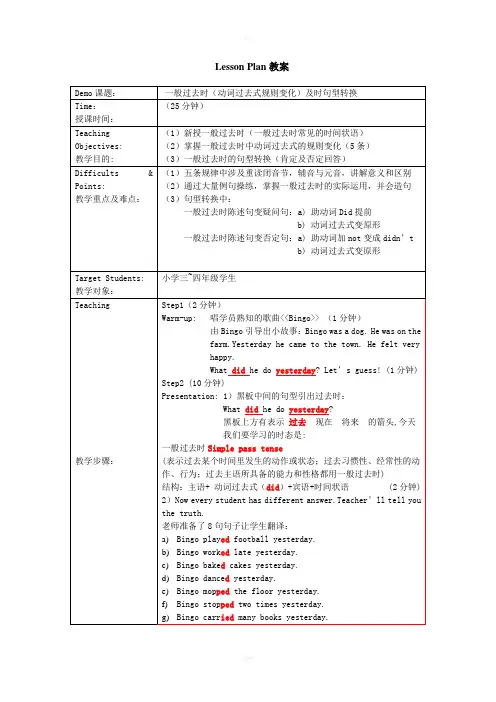
Lesson Plan教案Step1(2分钟)Warm-up: 唱学员熟知的歌曲<<Bingo>> (1分钟)由Bingo引导出小故事:Bingo was a dog. He was on thefarm.Yesterday he came to the town. He felt veryhappy.What did he do yesterday? Let’s guess! (1分钟) Step2 (10分钟)Presentation: 1)黑板中间的句型引出过去时:What did he do yesterday?黑板上方有表示过去现在将来的箭头,今天我们要学习的时态是:一般过去时Simple pass tense(表示过去某个时间里发生的动作或状态;过去习惯性、经常性的动作、行为;过去主语所具备的能力和性格都用一般过去时)结构:主语+ 动词过去式(did)+宾语+时间状语 (2分钟) 2)Now every student has different answer.Teacher’ll tell you the truth.老师准备了8句句子让学生翻译:a)Bingo play ed football yesterday.b)Bingo work ed late yesterday.c)Bingo bake d cakes yesterday.d)Bingo dance d yesterday.e)Bingo mop ped the floor yesterday.f)Bingo stop ped two times yesterday.g)Bingo carr ied many books yesterday.. .。
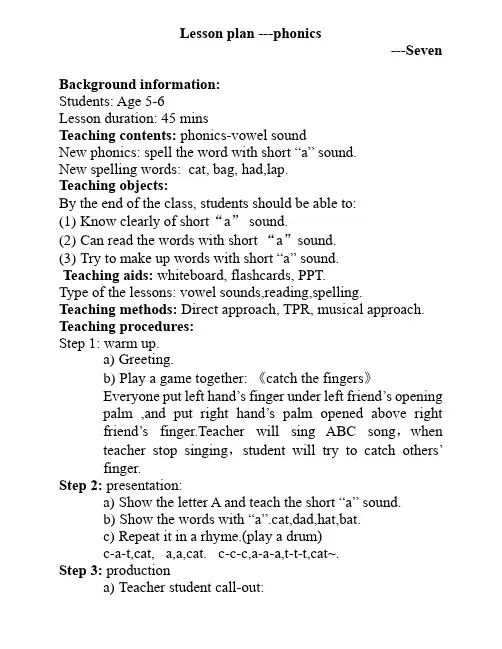
Lesson plan ---phonics---Seven Background information:Students: Age 5-6Lesson duration: 45 minsTeaching contents: phonics-vowel soundNew phonics: spell the word with short “a” sound.New spelling words: cat, bag, had,lap.Teaching objects:By the end of the class, students should be able to:(1)Know clearly of short“a” sound.(2)Can read the words with short “a”sound.(3)Try to make up words with short “a” sound.Teaching aids: whiteboard, flashcards, PPT.Type of the lessons: vowel sounds,reading,spelling.Teaching methods: Direct approach, TPR, musical approach. Teaching procedures:Step 1: warm up.a)Greeting.b)Play a game together: 《catch the fingers》Everyone put left hand’s finger under left friend’s openingpalm ,and put right hand’s palm opened above rightfriend’s finger.Teacher will sing ABC song,whenteacher stop singing,student will try to catch others’finger.Step 2: presentation:a)Show the letter A and teach the short “a” sound.b)Show the words with “a”.cat,dad,hat,bat.c)Repeat it in a rhyme.(play a drum)c-a-t,cat, a,a,cat. c-c-c,a-a-a,t-t-t,cat~.Step 3: productiona)Teacher student call-out:Teacher reads the sound:c-a-t,then teacher point out ,Student says the word:cat.b)Passing the sound.Devise students to two groups and line up.Teacher show a word,students pass the word one by one and write it on the whiteboard.Step 4: practicec)Copy cat: students exactly copy what teacher said.d)Boo Boo catcher:Teacher reads the words, students find the mistake and correct teacher.Step 5: performinga)Everyone holds one consonant letter,teacher will call the letters, then student will make up a word with “a” in the middle. Step 6: summarizinga)Recall what we have learned today.b)Emphasize the key point.Step 7: homeworkColor the short “a” in red,and spell it.Color the short “a” in red,and spell it.。
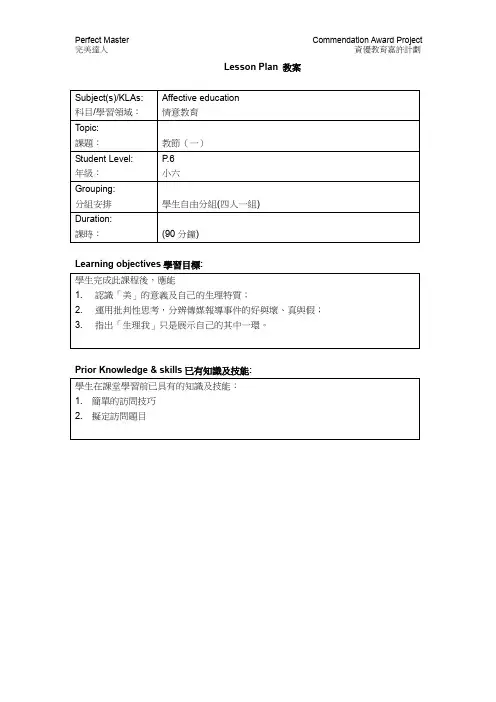
Lesson Plan 教案
Learning objectives學習目標:
Prior Knowledge & skills已有知識及技能:
教學活動及流程:
# 展示在教學活動中為照顧高能力/資優學生而調適的教學內容和策略。
學習評估:
Lesson Plan 教案
Learning objectives學習目標:
Prior Knowledge & skills已有知識及技能:
教學活動及流程:
#展示在教學活動中為照顧高能力/資優學生而調適的教學內容和策略。
學習評估:
Lesson Plan 教案
Learning objectives學習目標:
Prior Knowledge & skills已有知識及技能:
教學活動及流程:
香港進食失調康復會有限公司派員到校主講《瘦身文化面面觀》講座
全級進行
# 展示在教學活動中為照顧高能力/資優學生而調適的教學內容和策略。
學習評估:
Lesson Plan 教案
Learning objectives學習目標:
Prior Knowledge & skills已有知識及技能:
教學活動及流程:
#展示在教學活動中為照顧高能力/資優學生而調適的教學內容和策略。
學習評估:
Lesson Plan 教案
Learning objectives學習目標:
Prior Knowledge & skills已有知識及技能:
教學活動及流程:
#展示在教學活動中為照顧高能力/資優學生而調適的教學內容和策略。
學習評估:。
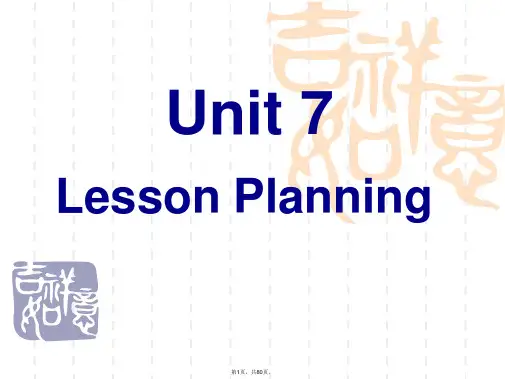
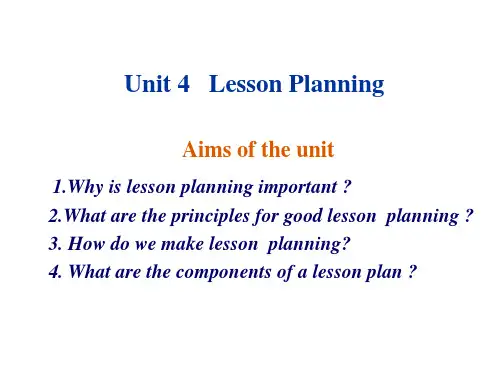
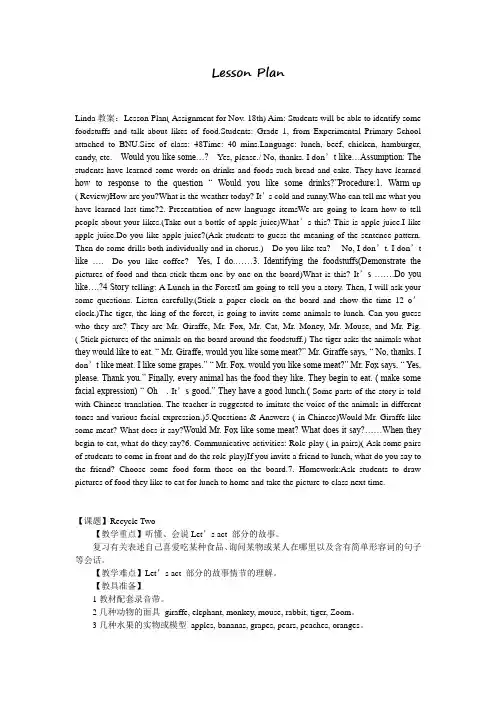
Lesson PlanLinda教案:Lesson Plan( Assignment for Nov. 18th) Aim: Students will be able to identify some foodstuffs and talk about likes of food.Students: Grade 1, from Experimental Primary School attached to BNU.Size of class: 48Time: 40 nguage: lunch, beef, chicken, hamburger, candy, etc.---Would you like some…?---Yes, please./ No, thanks. I don’t like…Assumption: The students have learned some words on drinks and foods such bread and cake. They have learned how to response to the question “ Would you like some drinks?”Procedure:1. Warm-up ( Review)How are you?What is the weather today? It’s cold and sunny.Who can tell me what you have learned last time?2. Presentation of new language itemsWe are going to learn how to tell people about your likes.(Take out a bottle of apple juice)What’s this? This is apple juice.I like apple juice.Do you like apple juice?(Ask students to guess the meaning of the sentence pattern. Then do some drills both individually and in chorus.)---Do you like tea? ---No, I don’t. I don’t like ….---Do you like coffee?---Yes, I do.……3. Identifying the foodstuffs(Demonstrate the pictures of food and then stick them one by one on the board)What is this? It’s …….Do you like….?4 Story-telling: A Lunch in the ForestI am going to tell you a story. Then, I will ask your some questions. Listen carefully.(Stick a paper clock on the board and show the time 12 o’clock.)The tiger, the king of the forest, is going to invite some animals to lunch. Can you guess who they are? They are Mr. Giraffe, Mr. Fox, Mr. Cat, Mr. Money, Mr. Mouse, and Mr. Pig. ( Stick pictures of the animals on the board around the foodstuff.) The tiger asks the animals what they would like to eat. “ Mr. Giraffe, would you like some meat?” Mr. Giraffe says, “ No, thanks. I don’t like meat. I like some grapes.” “ Mr. Fox, would you like some meat?” Mr. Fox says, “ Yes, please. Thank you.” Finally, every animal has the food they like. They begin to eat. ( make some facial expression) “ Oh---. It’s good.” They have a good lunch.( Some parts of the story is told with Chinese translation. The teacher is suggested to imitate the voice of the animals in different tones and various facial expression.)5.Questions & Answers ( in Chinese)Would Mr. Giraffe like some meat? What does it say?Would Mr. Fox like some meat? What does it say?……When they begin to eat, what do they say?6. Communicative activities: Role-play ( in pairs)( Ask some pairs of students to come in front and do the role-play)If you invite a friend to lunch, what do you say to the friend? Choose some food form those on the board.7. Homework:Ask students to draw pictures of food they like to eat for lunch to home and take the picture to class next time.【课题】Recycle Two【教学重点】听懂、会说Let’s act 部分的故事。
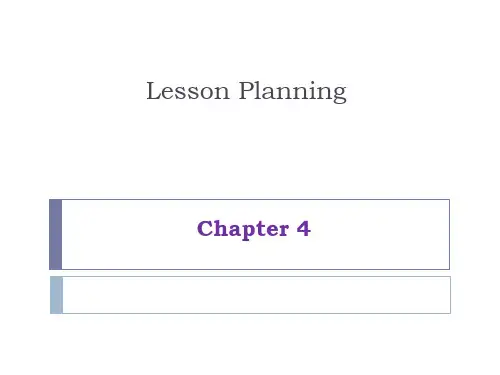
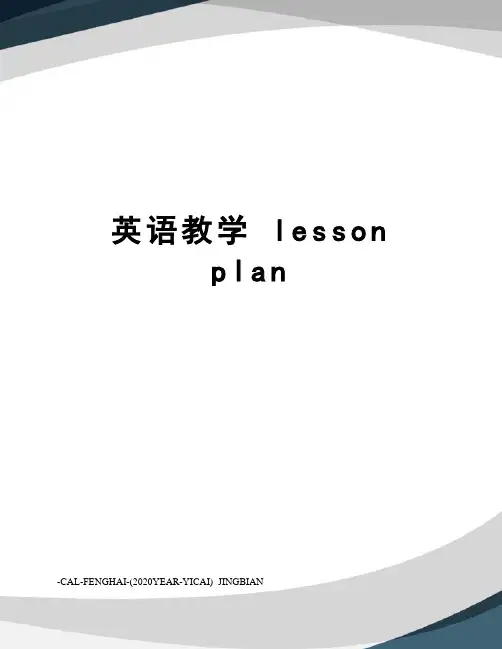
英语教学l e s s o np l a n-CAL-FENGHAI-(2020YEAR-YICAI)_JINGBIANLesson PlanI. Teaching material and learning condition1. The analysis of teaching materialThe teaching material is from Go For It Book 8A Unit 10 section A. The topic of this unit is about future intentions. The passage is a dialogue between a boy and a girl about …... Besides, there are some useful expressions. So in this lesson, students are going to learn 6 new words and some key sentence patterns.2. The analysis of learning conditionThe students are from grade 2 in junior high school. As junior high school students, they have acquired some words about jobs. Even though the topic future intention is familiar to them, still some of the Ss can’t ask others about their future intentions accurately and fluently. With the limited vocabulary, the students may lack of rich words to show their dreams. However, the passage 1a and 1c offer nice models for students to imitate.II. Teaching aims1 Knowledge aims(1) By the end of the class, the students are able to understand the passage.(2) T he students are able to use the sentence patterns” What are you going to be…”“I’m going to be a/an…”“How are you going to do that?”“I’m going to…”(3) The students are able to master the new words: computer programmer, professional basketball player, pilot, engineer, teacher and actor.2 Ability aims(1) The students are able to read the passage clearly and fluently.(2) The students are able to use the key sentence patterns to make conversations.(3) The students are able to listen, speak, write and use the new words and understand other words about jobs mentioned in our class.3 Affect aimsStudents will know the features of jobs and have their own future plan. What’s more, they will aware of that only when they work hard, can they achieve their dreams.Language focuses and anticipated difficulties1 Language focusesThis is a listening and speaking period so the focus is to cultivate the students’ listening and speaking skills. The many activities are designed to help Ss to train their listening and speaking skills, such as pair work, ask and answer, listen to the tape and fill in the blanks.It is also important for the Ss to master the new words and target language.2 Anticipated difficultiesAs the Ss have a limited vocabulary, so they may have difficulty in using the new words naturally and fluently in real situations. Besides, they may have problems in using the key sentence patterns naturally and fluently in making conversations.3 SolutionsBased on the different circumstances, I’ll adopt different solutions. For example, if Ss can’t use target language to make dialogues naturally, I’ll let them practice more and speak more in the class.Teaching methodWell, how to achieve the teaching goals better, to stress the key points and break through the difficult pointsThe key is how to make use of the proper teaching methods.So in this lesson, I plan to use Communicative language teaching, Situational language teaching, Task-based language teaching, The Audio lingual language teaching and CAI.Teaching aidsTapes, blackboard, chalks, multimedia devices and PPT documents: In order to help Ss to fully understand the whole passage, I adopt multimedia devices and PPT documents to bring the real-life situation into the classroom. Teaching proceduresStep1 Warm-up (6min)Activity 1 Watch a video frequency about basketball player Activity 2 Free-talkingAfter watching the video frequency, teacher asks the Ss:” Do you know what are they”, “Do you like playing basketball”” Do you want to be a basketball player?” and so on. Ss answer the questions individually. Then teacher leads into the topic: future intentions.Purpose: In this step, teacher first shows a video frequency, and then leads in the topic by talking with the Ss freely. It will help to arouse the Ss' participation desire, and lead the Ss into a relaxing English studying atmosphere at the beginning of the class. Good beginning is half done. And the most important purpose is to show the main clue of the whole class.Step2 Presentation and practice (22min)Activity 1 Present key words with pictures one by oneBefore presenting the new words, teacher shows Ss pictures of jobs and ask them questions, “what is he/she?” after answering questions, teacher presents the new words in the same PPT and teach Ss the pronunciation and spelling.Activity 2 BrainstormingTeacher designs a game for Ss. T divides the whole class into 4 groups, each group chooses a representative. The 4 Ss come to the blackboard and write down the jobs they know. Which one writes the most, his group wins. This is a kind of brainstorm; it can help arouse students’ interest of study.Activity 3 Present key sentence structure and passageT displays key sentence structures:” What are you going to be…”“I’m going to be a/an…”“How are you going to do that?”“I’m going to…”Above all, all the language points have been shown. Then T will present the passage and let Ss read it together.-“What are you going to be when you grow up?”-“I’m going to be a computer programmer.”- “How are you going to do that?”- “I ’m going to study computer science.”Activity 3 Pair workT shows Ss pictures about several jobs, puts on some phrases on the PPT.Ss make dialogues according to the pictures and phrases.For example: What are you going to be when you grow up? A pilotHow are you going to do that Learn more about science exercise everydayActivity 4 what do you think of these jobsT let Ss do the exercise as follows:Do you think these jobs are interesting? Rank them from [1--6] (1 is mostinteresting, 6 is least interesting.)___ Computer programmer___ Baseball player___ Pilot___ Engineer___ Teacher ___ ActorActivity 5 Listen to the tape and fill in the blanksT let Ss listen to the tape and finish the exercise in the textbook. It can make the students concentrate on the listening materials.Step3 Consolidation (10min)It’s important for students to speak English as much as possible in class orafter class. So in this part, I show students a picture. Students are required towriterteacher pilotactor interesting difficult (hard)easy boring excitingpractice the conversation in the picture. Then they make conversations aboutthe other jobs.Model: A: What are you going to be when you grow up?B: I’m going to be a reporter.A: How are you going to do that?B: I’m going to write articles and send th em to magazines and newspapers.A: When are you going to start?B: I’m going to finish high school and college first.A: Where are you going to work?B: I’m not sure. Maybe Beijing or Shanghai.A: Good luck!B: Thank you!Step4 Extension (6min)It’s ne cessary for Ss to do some extensive exercise in class to strengthen the knowledge they learned. So in this step, I display some exercises to let themmaster the new words and target sentence structures better.Exercise A1. I like computer. I’m g oing to be a c________ ____________.2. The actor ___going to New York.3. How ____you going to do that4. The boys___ _____ ___ play soccer.5 .___there ______ to ____ a fashion showExercise BA: (1) ______________________B: I'm going to buy a present(礼物).A: (2) __________________________B: I'm going to give it to my English teacher.Exercise C1—Are you going to be _____ actor?—Yes. I’m taking _____ acting lessons.A. a; theB. an; 不填C. the; anD. 不填; the2. —_____ are you going to keep healthy?—I’m going to exercise every morning.A. HowB. WhereC. WhyD. When3. —where are you going to live?—_____. Maybe Beijing or Tianjin.A. Yes, pleaseB. I’m not sureC. Don’t worryD. Good idea4. —My New Year’s resolution is to learn to play an instrument.—_____A. Sounds great.B. Sorry to hear that.C. What about you?D. Sure, I’d love to.Step5 Homework (1min)In order to let the Ss to review the learned knowledge and speak English more after class, I assign the homework as follows:1. Copy the new words.2. Write a composition about your plans for the future.3. Read the passage in the textbook after the tape.Blackboard design08051129 华夏怡。
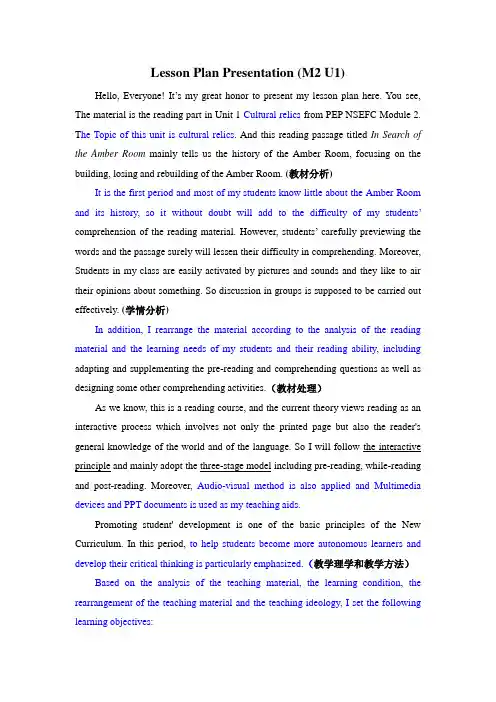
Lesson Plan Presentation (M2 U1)Hello, Everyone! It’s my great honor to present my lesson plan here. You see, The material is the reading part in Unit 1 Cultural relics from PEP NSEFC Module 2. T he Topic of this unit is cultural relics. And this reading passage titled In Search of the Amber Room mainly tells us the history of the Amber Room, focusing on the building, losing and rebuilding of the Amber Room. (教材分析)It is the first period and most of my students know little about the Amber Room and its history, so it without doubt will add to the difficulty of my students’comprehension of the reading material. However, students’ carefully previewing the words and the passage surely will lessen their difficulty in comprehending. Moreover, Students in my class are easily activated by pictures and sounds and they like to air their opinions about something. So discussion in groups is supposed to be carried out effectively. (学情分析)In addition, I rearrange the material according to the analysis of the reading material and the learning needs of my students and their reading ability, including adapting and supplementing the pre-reading and comprehending questions as well as designing some other comprehending activities.(教材处理)As we know, this is a reading course, and the current theory views reading as an interactive process which involves not only the printed page but also the reader's general knowledge of the world and of the language. So I will follow the interactive principle and mainly adopt the three-stage model including pre-reading, while-reading and post-reading. Moreover, Audio-visual method is also applied and Multimedia devices and PPT documents is used as my teaching aids.Promoting student' development is one of the basic principles of the New Curriculum. In this period, to help students become more autonomous learners and develop their critical thinking is particularly emphasized.(教学理学和教学方法)Based on the analysis of the teaching material, the learning condition, the rearrangement of the teaching material and the teaching ideology, I set the following learning objectives:First, language skills.At the beginning of this class, students will be able to predict the content according to the title and the pictures and get the general idea of the passage by skimming, then find out some specific information about the passage by scanning. By the end of the class, they will manage to retell the history of the Amber Room and discuss with the partner on how to protect our cultural relics.Second, language knowledge.During learning, students can understand and master the useful words and expressions such as cultural relics, survive, in return, and so on.Third, affect and cultural awareness. Students will realize the importance of giving love to the cultural relics, and have strong desire to protect them. Thus ,they can discover the sufferings from war and deepen their feelings of loving peace.Last, learning strategy . Students will learn autonomously and cooperatively in different activities before, during and after reading, and communicate actively with their partners in discussing the question on how to protect our cultural relics. (教学目标)Among these learning objectives, it is considered a s the language focus that students can obtain the general idea and some specific information about the histroy of the Amber Room by skimming and scanning and use the words and expressions learned in this unit to retell the history of the Amber Room. While t he difficult point would be discussing the question on how to protect the cultural relics using some related knowledge learned in this period.(重点、难点分析)In order to achieve the objectives above, several activities are designed in the three stages.In pre-reading stage, there are two activities within 5 minute s. Activity 1 is talking. Students watch a short video clip of a movie "Yuan Ming Yuan" before class and try to guess what today's topic is. Then they describe the pictures of cultural relics at home and abroad, using words from a vocabulary pool like fashionable, mysterious, valuable, and so on. Audio-visual method is adopted here to attracts Ss' attention and interest. The classroom atmosphere can also be activated by guessing , and the vocabulary pool here not only encourages and motivates students to talk, but alsooffer a chance for students to familiarize with the new word. Activity 2 is predicting. Students are asked to predict what happened to the Amber Room by looking at the picture about the Amber Room and the title of the passage. Thus, students' learning strategy of predicting is improved and their curiosity is aroused.In while-reading stage, I designed four activities which will spend 26 minutes. Firstly, students skim the whole passage to get the general idea of the passage. Activity 2 is close-reading for paragraph 4 and answering two questions: How did the Amber Room get lost? How could they steal such a big room in less than two days? Activity3 is scanning the whole passage to find out the four kings related to the Amber Room. So skimming and scanning ability can be both strengthened in this period. Activity 4 is also close-reading for paragraph two, three and five to search what these four governers did to the Amber Room in detail and how it was rebuilt. In this stage,various comprehending activities are designed to help Ss to have a full understanding of the whole passage.The last stage, post-reading stage needs the final 14 minutes. T wo activities are designed. Activity 1 is retelling. Students introduce the amazing history of the Amber Room to the visitor as a guide, using the linking words like first, then, after that, now, and so on. Placed in an imaginative situation, students are required to retell the history of the Amber Room, which can help students learn better about the words and expressions of this period and the content of the text as well. Activity 2 is discussion. Students discuss in group of four on the topic of how to protect cultural relics according to the situation in which the Amber Room in Russian is to be invited as a member of World Heritage list, while Chinese 5 members of World Heritage list as endangered members. So people are talking about how to protect our cultural relics and hold to our spiritual home in the Internet including our students. The real communication involves them on the topic and arouse s their responsibility of protecting the cultural relics. By discussing in groups, their critical thinking and autonomous learning can be developed.At the end of the class, I will present homework----- first surf the Internet to give advice in a web site given then retell two parts of the passage(describe the AmberRoom and the amazing history of the Amber Room).(教学步骤)It is my blackboard design. It contains the whole structure of the passage. First, the Amber Room was built by the four kings who did a lot for it. Then it was lost as a result of the Nazis' stealing. Finally, it was rebuilt by German and Russian. (板书设计)That's all for my lesson plan presentation. Thank you very much!。
竭诚为您提供优质文档/双击可除lesson,plan,模板篇一:lessonplan模板lessonplanunit2lesson1aperfectday(示例)本课是第xx单元第xx课。
本单元围绕xxx话题。
本课计划按两次课完成:第一次课关于warmingupandreadingcomprehension;第二次课xxxxx。
......(示例)period1:warmingupandreadingcomprehension(示例)(90min)objectives1.knowledgeobjectives:1)masterthenewwordsandexpressions2)tousetimelinkers,especiallyadverbsandconjunctions2.abilityobjectives:1)learnaboutthegeneralideaofthetextthroughfastreadi ng2)findoutthedetailedorspecificinformationthroughint ensivereading3)practicestudents’abilitytousethestrategyofpredicationandreference3.emotionobjectives:1)tolearntheheroicspiritofyangliwei2)togetandarrangetheinformationaboutspaceship3)todescribetheprocessoftheflightandthefeelingsofya ngbythewordsandexpressionslearnedinthislesson(此部分可根据实际情况删减)contents1.words:astronaut,flight,launch,rocket,atmosphere,helicopte r,parachute,gravity,manndspaceship,separate…from,becauseof,letout,millionsof......2.expressions:separatefrom与……分离,becauseof因为,由于,liftoff起飞,升空,发射......3.sentences:1)thespaceship,calledshenzhouⅤ,wascarryingchina’sfirstastronaut,yangliwei.2)whenthespaceshipwasdoingitsseventhcircle,yangliwe ishowedtheflagsofchinaandtheunitednations,expressin gthewishesofthechinesepeopletoexploreandusespacepea cefully.municativetasks:questionscanbebasedondetailsin thetext.whydopeoplethinkyangliweiisaherowhatcanwelearnfromyangliwei ……keypointsanddifficulties1.findoutthemainideaanddetailedinformationthroughex tensiveandintensivereading.2.todescribetheprocessoftheflightbythewordsandexpressionslearnedinthislesson.teachingapproachestask-basedteaching,scanning,intensivereading,rolepl ay,pair-worksdebutlaunch.长征七号运载火箭20xx年6月25日晚在海南文昌发射场首飞成功。
Lessonplan详细版编辑整理:尊敬的读者朋友们:这里是精品文档编辑中心,本文档内容是由我和我的同事精心编辑整理后发布的,发布之前我们对文中内容进行仔细校对,但是难免会有疏漏的地方,但是任然希望(Lessonplan详细版)的内容能够给您的工作和学习带来便利。
同时也真诚的希望收到您的建议和反馈,这将是我们进步的源泉,前进的动力。
本文可编辑可修改,如果觉得对您有帮助请收藏以便随时查阅,最后祝您生活愉快业绩进步,以下为Lessonplan详细版的全部内容。
Lesson planUnit 5 Traveling AbroadPeriod 1 Warming-up and readingTime: 45 minutesThe number of students: 50The grade of students: grade two in high school1.The analysis of teaching materials:This unit forms a part of high school English teaching material, Student’s Book 7. This unit can be divided into three parts: warming-up, reading,listening about language. Its main topic is traveling abroad and it contains two reading materials, studying in foreign country and traveling in foreign country。
Today,we will learn the first part,studying in a foreign country。
In this unit,it tells students what problems they will meet in foreign countries and how to deal with these problems. Also, it introduces the benefits and difficulties of studying abroad through the story of Xie lei.2.The analysis of students:As high school students, they have learned English for several years and they have a basic command of English. Students will be interested with a certain topic easily, such as traveling, sports healthy life and so on,which adapts to their physical and psychological characteristics。
托福口语lesson planLesson Plan: TOEFL SpeakingObjective:To improve students" speaking skills for the TOEFL exam by practicing and developing their ability to respond effectively to various speaking tasks.Materials:1. TOEFL speaking prompts/questions2. Timer/stopwatch3. Whiteboard/markers4. Handouts with scoring rubrics and sample answersProcedure:1. Warm-up Activity (5 minutes):- Start the class with a quick warm-up activity to get students speaking and thinking in English.- Ask each student to introduce themselves and share one interesting fact about themselves.- Encourage other students to ask follow-up questions to keep the conversation going.2. Introduction to TOEFL Speaking (10 minutes):- Explain the format and requirements of the TOEFL Speaking section.- Go through the scoring rubrics, highlighting the key criteria for each task.- Provide students with handouts containing sample answers and scoring rubrics.3. Task Types Overview (10 minutes):- Introduce the different task types in the TOEFL Speaking section.- Explain the structure and expectations for each task type.- Provide examples of each task type and discuss strategies for approaching them.4. Task Practice (45 minutes):- Divide students into pairs or small groups.- Distribute TOEFL speaking prompts/questions to each group.- Set a timer for each task, based on the time limits given in the TOEFL exam.- Instruct students to take turns performing the task and providing feedback to each other.- Encourage students to use the scoring rubrics and sample answers as a guide for evaluation.5. Group Discussion (15 minutes):- Bring the class back together and lead a discussion about the task practice.- Ask students to share their observations, challenges, and strategies from the practice session.- Address any questions or concerns raised by the students.6. Wrap-up and Feedback (5 minutes):- Summarize the key points discussed during the lesson. - Provide additional tips and strategies for improving TOEFL Speaking skills.- Ask students for feedback on the lesson and if they have any specific areas they would like to focus on in future lessons.Extension Activity Suggestions:- Assign homework tasks for students to practice on their own and bring their responses to the next class for evaluation.- Incorporate mock TOEFL Speaking tests into future lessons to simulate the exam experience and provide more extensive practice.Note: The duration of each activity can be adjusted based on the class"s proficiency level and needs.。
英语句型教案英文Title: English Sentence Structure Lesson PlanObjective:- To introduce and reinforce the understanding of basic English sentence structures- To enhance students' ability to construct grammatically correct sentences- To encourage students to apply their knowledge of sentence structures in speaking and writing activitiesLevel: IntermediateDuration: 60 minutesMaterials:- Whiteboard or blackboard- Markers or chalk- Handouts with sentence structure examples- Sentence structure worksheets- Pencil or pen for each studentProcedure:1. Warm-up (5 minutes):- Greet the students and ask them to share a sentence they find challenging to construct in English.- Write some of the sentences on the board and discuss possible reasons for the difficulty.2. Introduction (10 minutes):- Explain the importance of understanding sentence structures in English for effective communication.- Present the basic components of an English sentence: subject, verb, and object.- Provide examples of different sentence structures, such as subject-verb (SV), subject-verb-object (SVO), subject-verb-indirect object-direct object (SVIDO), etc.- Use visual aids or handouts to help students visualize the sentence structures.3. Guided Practice (15 minutes):- Distribute the sentence structure worksheets to the students.- Instruct them to complete the sentences using the correct sentence structure provided.- Monitor their progress and provide assistance as needed.- Review the answers as a class, discussing any common mistakes or misconceptions.4. Interactive Activity (20 minutes):- Divide the class into pairs or small groups.- Provide each group with a set of sentence structure cards (e.g., subject, verb, object).- Instruct the students to take turns arranging the cards to form grammatically correct sentences.- Encourage the students to create as many sentences as possible within a given time frame.- Monitor the groups and provide feedback on their sentence structures.5. Application (10 minutes):- Ask the students to individually write three sentences using different sentence structures.- Collect their sentences and review them for accuracy and creativity.- Provide constructive feedback on their sentence structures and offer suggestions for improvement.6. Wrap-up and Closure (5 minutes):- Recap the key points covered in the lesson, emphasizing the importance of sentence structures in English.- Address any remaining questions or concerns from the students.- Assign relevant homework exercises to reinforce the understanding of sentence structures.Note: The duration of each activity can be adjusted based on the students' proficiency level and engagement. It is essential to provide ample opportunities for students to practice constructing sentences and receive feedback on their progress.。
Lesson Plan InterpretationGo for it Students k HBooGood afternoon ladies and gentlemen. It's my pleasure to interpret my lesson here today. The lesson plan I ' mgoing to talk about is from Go for it Students' Book 川Unit 10 I'm going to be a basketball player. I'll explain how to teach and why to do so from the following 4 aspects: understanding of the teaching material, teaching methods and studying ways, teaching procedure, blackboard work..I、Understanding of the teaching material1.Status and functionThe theme of Unit 10 is about life goals.Ss are familiar with this topic.This is an interesting topic to Ss. So all the activities in this unit are helpful to raise students ' learning intereIsnt.this petiod, I will teach the key vocabulary about jobs firstly and alone,then the target language with some new words.By some activities,Ss learn how to achieve their life goals.Aftet presenting the new learning poits,I will arrange Ss to listening,speaking and reading practise.This activities can help Ss improve their intergrating skills. The target language is the basic for Ss to learn the other contents of this unit. So it ' s very importan this lesson well.2.Teaching aims and demands:Based on the analysis of the teaching material, I make out the following objectives:a)Knowledge objectivesThe first one is knowledge objectives. Students should master and use the key words and phrases properly, such as pilot, computer programmer, profess ional basketball player …They should know how to use be going to be a /a n •••"express their dream jobs. Stude nts also should know to use the new lear nt stucture“be going to do ”to explain their wat to achieve their goals.b)Ability objectivesThe second is ability objectives. Students are the real master of the class. I will give their more chance to speak out by pairwoks and groupworks. In this way, I can improve students'ability of coopetating with others. Ability of listening is also the point I 'dlike to emphrasize on. Based on exercise,they will listen to a piece of material with exact direction. The ability of making a small survey is also an importance I want to improve.c)Moral objectivesThe third is moral objectives. This is a topic about their future,which students are interested in. whati is the most important thing is that how to achive their goals. They should have a clear understanding of the significance of studying hard and cultivating good habits.3.Teaching important pointsNow I talk about the important points. Based on the teaching aims, the important points of this lesson are words and the usage of “be going to be a/an …” “ be going to do ” .4.Teaching difficult pointsAs to the difficult points, most students should use the pattern“be going to do/be a/an …” to express their dream job,and the way to their goals.n> Analysis of the studentsThe students have learnt English for more than one year. They know some English, but some of them didn ' t learn it well. Especiallyt,hmemosatroef afraidto speak English. For this lesson,the students have known the patternwill be”.Most of them can use the pattern correctly. But they don'tknow to use”be going to' as future. Most students have mastered the simple jobs,such as teacher,doctor—but they don 'tk now the relative difficult words like computer programmer,pilot,professi onal basketball player …So this is what I teach in this periodIII 、Teaching methods and studying ways1. Teaching methodsNext I will focus on the teaching methods. As we all know, the main instrbctional aims of learning English in the middle school is to cultivate students ' abilities of listening, speaking, reading, writing and their good sense of the English language. So in this lesson I ' ll mathinelyCuosmemunicative Approach,and Task-basedLanguage Teaching as the mainteaching methods.That is to say, I ' ll let the Ss get a better understanding of the target language. I ' ll give the Ss some tasks and arrange 4 kinds of activities: making up conversationgs,listening practise,group work activities,making a small survey and report.2.Studying waysAs for the studying ways,students will learn through speaking out and communicating and coopetating with their partners. They also should pay attention to the key imformation in listening practise.I' ll use PPt as my teaching aids. IV 、Teaching procedureHere comes the most important part, my teaching procedure, it includes 6 steps: Step 1: Greeting and Revision, Step 2: Lead-in, Step 3: New words learning and drill, Step 4: Presentation and practice, Step 5: Making a survey, Step 6:Presentation, Step 7: Practice, Step 8:Listening,Step 9 Pair work, Step10:Homework Step 1 GreetingIt will costs 1min. I will talk with them about some simple communication language every time I meet them. Let them enter into the English environment as soon as possible Step 2 Lead-inGo over some words of jobsIt will costs 3 mins. Firstly I 'll show picture one of a teacher,ask:What does he do? All the students can guess according to the picture. He is a teacher. I ask them to spell it. Then to the rest of the picture I do the same job.This task revise the simple jobs learnt before. Which is the basic of this lesson.Step 3 New words learning and drillIt costs5mins. In this part, I just teach the new words with the learnt sentence,and then teach the new stucture. As is known to all, middle students should learn English step by step. Before they learn the new structure,students are asked to master the new vocabulary. It is important to pay all the attention to learn new words. They can learn them better than mix new vocabulary with new structure. Task 1 Teach new words of jobs usin“g What does he/she do”I will show the first picture and ask:Who is he?What does he do? Ss can guess according to the picture.He is Yaoming. He is basketball player. I will tell them more. He makes a living by playing basketball. He makes money by playing basketball. So he is a professional basketball playe专业的篮球运动员).Ask them to spell it and write it on Bb. At the same time,I write the pronouciation of some vowel. Read after me by different way,such as Group A,Group B,Group C,boys,girls…repeat the qestions and answers again. The next 4 pictures of pilot, computer programmaer I use the same way to teach.This activityTask 2 practice and consolidat“e What do you want to be when you grow uo”?Say:Boys and girls, there are many kinds of jobs in the world. Do you want to do know more? I ask one of the top students to answer my questio“nWhat do you want to be when you grow uo?”.After that, I show the new sentence“What do you want to be when you grow uo?”and explain what the meating of “grow up”. Write it on the Bb. I ask some of the students to answer this question. Next it is their time to drill. They work in pairs. 2 mins later, I ask most of the group to present.With the task, I encourage them to speak out and express their life goal by using the pattern. Working in pairs improve their ability to cooperate with others.Step 4 Presentation and PracticeIt costs10 mins.Task 1 Present the new structureI will present the new structurei in the PPT,and highlight the new expressio“n be going to be”by red print. I explain the meaning in details. Read the sentence together. They should use the words we learnt today to answer this question.This task introduces the new language point. With the new expression in mind, students can tell their life goal in a right way.Task 2 Pair work:practise and consolidate the new strcture in pairs Task 3 Some pairs doI ask the Ssto look at the screen and read after me : ------ What are you going to bewhe n you grow up? ---- I'm going to be a / an ….whe n I grow up.Then I ask the Ss to work in pairs to talk about one of the pictures. Ask some pairs to act them out to check the pronunciation.This activity provides guided oral practice using the target language.Task 4\ Group wok: continue to practice and consolidate the new structur i e n s groups of 3,adding“What is he / she going to be when he / she grows up”?I will ask one student“What are you going to be when you grow up?” .The Student will tell me his life goal,then I ask his neighbour:What is he going to be when he grow up? The stude nt will tell:he is going to be a/an…whe n he grow up. Excha nge to a girl and ask her the same questions to her neighbour. Now they can understand the usage of the new learnt structure.Ask the students to work in group of 4 to talk about their partner's future job. Ask the Ss to use the different form of verb“be” correctly.Step 5 Making a surveyIt will costs 4mins,Task 1 Section A 1aBefore the task I will explain what is the meaning of “the most/least interesting”,I get them have a better understanding of the phrases.I ask the students to turn to page 59,pay attention to 1a. They are asked to finish the task all by themselves.This activity cultivatte the ability of finish the work independence,To this exercise,the answer is open. There is not a unitary answer. They can answer the question in various way.Task 2 talk about himself using the above structures and new words.I will ask some of the students to show their ideas,then I also share my own opinion with them.This activity also allow them to understand others better. I plant the idea in their mind that studentsshould share their view with their friends and classmates. Step 6 PresentationIt will cost 3 mins. In this step, I will show some sentences which is from SectionA 1b.I tell them they can answer the questio“n If you want to be / an ..., how are you going to do that? I am going to•…” with these phrases. Then I will ask some of the students to answer my question.This activity introduce some new phrases and structure. It is the preparation of next practice.Step 7 PracticeIt will cost 8 mins. I will show the picture on the PPT with the model like this(point to the PPT). I ask some of the students to answer these question. After Ss learned how to make invitations, how to accept or decline invitations, it is time for Ss to practise the target language.It is aimed to give the other Ss an example to do the group work.Task 2 Practice the above structures in pairsI will ask Ss to practise the conversation in pairs according to themselves. Later, I will let some pairs to present their dialogue in the class.This activity encourages students to speak out and master the new mo“deHlow are you going to do that?” . It left better understanding of the way to achieve their goals. Step 8 Listening It will cost 4 mins. I ask them to listen to the tape carefully and complete 2a independently. After checking the answer they are asked to turn to page 90 of tapescrips. Read after the tape one sentence by one sentence. Listen again and finish 2b.This task aims to improve their ability of listening and reading. They are asked to read with the tape,but not freely. It is an effective way to emphasize on pronounciation. Step 9 Group work:Survey and reportIt will costs 6 mins. In this step, I ask students to make a small survey by ask their groupmate the question. They should write down the name,what,how in the chart(point to the PPT). they will choose a student as representative,and the representative should report their result like this(point to PPT).This activity improve the ability of cooperating with others and share their ideas with them. They also clear what's their future goals and how their dream comes true. Step 10 HomeworkIt will cost 1 min. The last step is to assign the homework. There are two. One is finishing workbook page25. It is aimed to consolidate what they have learned today and help Ss to establish the structures of language points. The other is previewing page61. The purpose of this work is to predict what they will learn in next period. After previewing, students may have some problems,so they can have class purposely.5.Blackboard workOk, this is my blackboard design. On the top is the title of this lesson. And I will write some key words and phrases on the left and the structures of the expressions on the right.。